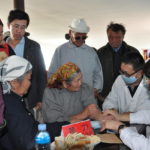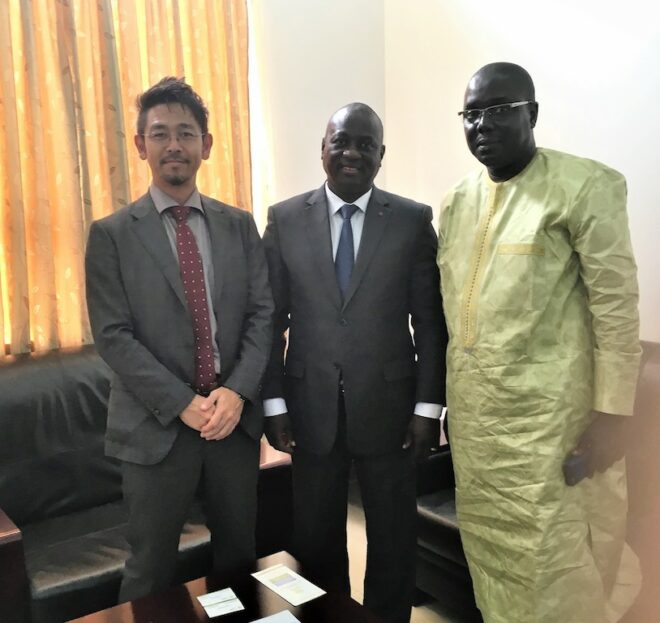
Satoyama Takanori (left) with Nicolau Dos Santos, Minister for Agriculture of the Republic of Guinea-Bissau (center), and Ibrahima Sall, a Senegalese CARD Regional Consultant
COURTESY OF SATOYAMA TAKANORI
The goal of doubling rice production in Africa by 2018, which was set by the Coalition for African Rice Development (CARD) in 2008, is likely to be almost achieved. But the gap between rice supply and demand is still large, and Africa remains dependent on imported rice. The Japan Journal spoke with Satoyama Takanori, who has engaged in agricultural development mainly in Africa as an expert of the Japan International Cooperation Agency (JICA) and Food and Agriculture Organization of the United Nations (FAO) for about fifteen years, about ongoing efforts to improve the quality and production volume of African rice.
Rice is ranked alongside wheat and corn as a major global grain. According to “Food Outlook,” which was published by the Food and Agriculture Organization of the United Nations (FAO) in July 2018, global rice production for the 2018/2019 season is projected to hit an all-time high of 511 million tons, an increase of 1.4% from last year. Rice is produced and consumed mainly in Asia, but rice production and consumption have been increasing in Africa as well in recent years. According to FAO statistics, rice production in Sub-Saharan Africa was 14.5 million tons on annual average from 2005 to 2007, but it reached 26 million tons in 2016. Rice consumption has also risen rapidly since the 1990s. Rice is a relatively new crop in Africa except for a few countries such as Mali, Guinea, Liberia, Sierra Leone and Madagascar, where people have long eaten it. Today, however, rice is consumed more commonly than it used to be in many other countries as well, especially in their urban areas. Rice consumption, however, outpaces production in Africa, and African countries currently depend on imported rice mainly from Asia for about 60% of their consumption.
“One of the reasons for the increase in rice consumption in African countries is the rise of the middle class along with economic growth. Africans generally prefer rice to other staple crops for its taste and easiness to cook,” says Satoyama Takanori. “Generally speaking, imported rice is more popular than locally produced rice in Africa. Imported rice is better in terms of quality, taste and even price. For this reason, much of the rice produced in Africa is still unable to compete with imported rice.”
Satoyama has engaged in agricultural development mainly in Africa as an expert of the Japan International Cooperation Agency (JICA) and FAO for about fifteen years. From 2012 to 2018, Satoyama was sent by JICA to the Secretariat of the Coalition for African Rice Development (CARD) in Nairobi, the Kenyan capital, as a general coordinator.
CARD was established by JICA, the Alliance for a Green Revolution in Africa (AGRA) and the New Partnership for Africa’s Development (NEPAD) at the Fourth Tokyo International Conference for African Development (TICAD IV), which was held in Yokohama, Kanagawa Prefecture in May 2008. CARD is a consultative group consisting of bilateral and multilateral donors and African/international institutions with the overall goal of doubling Sub-Saharan African rice production in ten years (from 14 million tons in 2008 to 28 million tons in 2018).
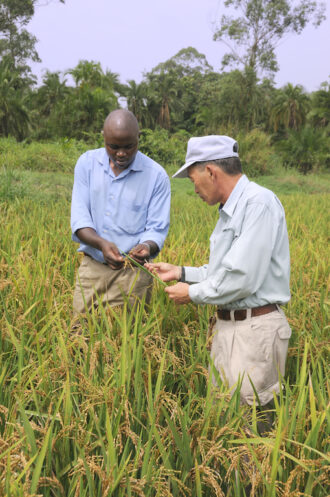
A Japanese expert (right) examines rice at the Namulonge Crop Resources Research Institute in Uganda.
COURTESY OF SHINODA YUJI/JICA
Low productivity is the main cause of the low agricultural production in Africa. Among the reasons for low productivity is insufficient utilization of fertilizer. An average of more than 150 kilograms of fertilizer is used for 1 hectare of arable land in Asia, but just 10 kilograms of fertilizer is used in Africa. In addition, the agricultural land cultivated with certified seeds makes up just 1% of the total cultivation areas in Africa. One of the reasons for low uptake of fertilizers and good seeds in Africa is its unstable climate, which is characterized by frequent droughts and floods. Although irrigation facilities are essential for agriculture in such an unstable climate, the areas under irrigation make up just 4% of the total cultivation areas. The unstable climate and the lack of irrigation infrastructure increase the risks in farming, and farmers, especially small-holders, avoid making extra investment in fertilizer and seeds in such a circumstance. The agricultural productivity in Africa, as a result, remains stagnant, thus it is difficult to increase the total agricultural production.
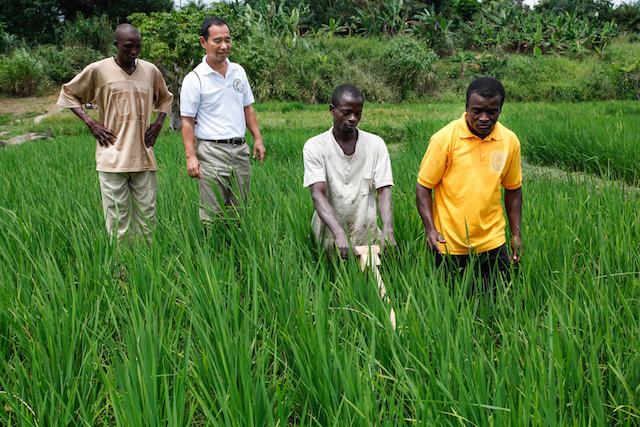
A Japanese expert teaches how to use a weeding machine as part of the Project for Sustainable Development of Rain-fed Lowland Rice Production in the Republic of Ghana.
COURTESY OF IIZUKA AKIO/JICA
In addition, the insufficient development of transport infrastructures is another major obstacle to increasing agricultural production. The marketing cost gets higher with a large distance between the rice production areas and markets or with roads in bad conditions, and these result in high price of African rice. Rice cannot even be marketed at all if the road network is not developed or bridges are not built at the critical spots. The capacity gap of farmers and rice millers is another issue to be addressed.
“In Africa, various socio-economic conditions prevent farmers from increasing their agricultural production in many areas. It is, therefore, necessary to provide comprehensive support to the whole value chain, from production to consumption” says Satoyama. “Individual countries need to set the right policy priorities, and donors and governments need to provide support in line with these priorities.”
One of CARD’s important activities is support to the government of twenty-three CARD member states in formulating and implementing the National Rice Development Strategy (NRDS). NRDS is a comprehensive strategy for achieving the rice development goals of respective countries; that is, formulated based on analyses of the current situation, selection of approaches to address issues and challenges, and appropriate target settings. A task force is formed mainly of government officials in each country, and takes charge of the formulation and implementation of the NRDS. After formulating the NRDS, the task force examines the gaps between the needs in the rice sector and the on-going and envisaged investments to identify priority areas for future interventions and investments. Following this, the task force formulates concept notes outlining the details of the projects, and conducts lobbying to stakeholders for the implementation of projects by government budgets or by donors and the private sector. In these NRDS processes, the task force continuously modifies and updates the specifics of projects by, for example, updating gap analyses in accordance with the constantly changing situation.
CARD does not provide direct financial support for implementation of projects. The CARD Secretariat rather provides a wide range of support for the smooth running of the NRDS processes by organizing workshops for task forces and backing up lobbying by the task forces for fund mobilization.
“NRDS, the commodity-specific national strategy on rice, is highly unique from a global perspective. Based on NRDS, several CARD member countries actively promote rice production with their own visions and strategic approaches,” says Satoyama. “Capacity building is another important function of CARD. The NRDS processes contribute a lot to building the capacity of stakeholders in the rice sector in CARD countries, including task force members. In addition, some countries apply the NRDS processes to other crops, and even to other areas beyond agriculture such as health sector.”
After CARD was established, 173 CARD-labeled projects were launched. Project partners include FAO, the World Bank, the African Development Bank (AfDB), the United States Agency for International Development (USAID) and JICA.
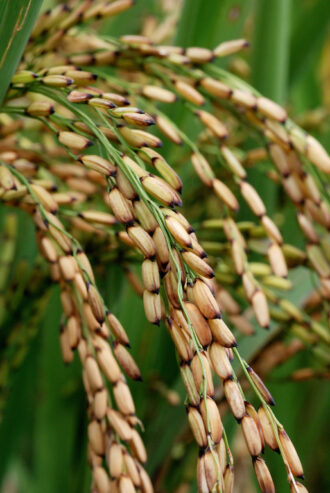
New Rice for Africa (NERICA)
COURTESY OF SHINODA YUJI/JICA
Of these CARD-labeled projects, JICA partners about twenty projects. For example, the Promotion of Rice Development Project (PRiDe) commenced in Uganda in 2011 as a technical cooperation project. This project is intended to provide support for developing and disseminating rice production techniques that are suitable for local areas, marketing and improving rice quality. The rice that this project seeks to promote is New Rice for Africa (NERICA). The NERICA varieties were developed by the West Africa Rice Development Association (WARDA) (the current Africa Rice Center) in the mid-1990s through the cross-breeding of the Asian and local African rice species. NERICA is so adaptable to African ecosystems as it requires less water for cultivation than Asian varieties and is also resilient against pests. In addition, NERICA can also be cultivated in 90 to 100 days, 30 to 50 days less than local varieties. Furthermore, the yield of African upland rice is 1 ton on average per hectare, but the yield of NERICA is about 2 to 3 tons on average. Training programs for farmers and agricultural extension workers were also conducted as a part of the project. As a result, more and more farmers began rice cultivation, leading to an increase in national rice production.
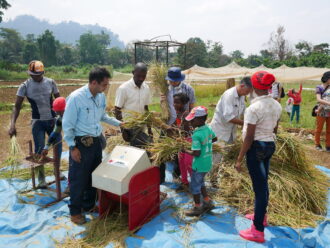
Children experience rice threshing at a family day arranged through the Project for the Upland Rice and Irrigation Rice Development in Cameroon.
COURTESY OF PRODRIP
In Cameroon, the Upland Rice Development Project of the Tropical Forest Zone was implemented from 2011 to 2016. In this African country, much of the rice produced under irrigated conditions in the northern and western regions has been traded to neighboring countries and not been provided in sufficient quantities to southern urban areas, where a large amount of rice is consumed. In addition, although the climate of the southern tropical forest zone was suitable for upland rice cultivation, rice farming had not spread widely. Focusing on these circumstances, the project placed importance on promoting upland rice, including NERICA, in Central Province where the capital Yaounde is located, and adjacent East and South Provinces. More specifically, the project provided support for developing upland rice varieties and cultivation techniques for the promotion of upland rice, training programs on upland rice cultivation for agricultural extension workers and farmers and post-harvest handling techniques for farmers, such as threshing and rice milling. Besides Cameroon, a Japanese expert who was dispatched to this project visited neighboring countries, such as the Democratic Republic of the Congo, Chad and Benin to disseminate rice cultivation. Currently, the Project for the Upland Rice and Irrigation Rice Development is underway to further disseminate upland rice production in Cameroon.
In terms of other technical cooperation projects, the Project for Sustainable Development of Rain-fed Lowland Rice Production in the Republic of Ghana was implemented from 2009 to 2014; the Project for Rice Productivity Improvement in Central Highland (PAPRIZ) from 2009 to 2015 and the Project for Rice Productivity Improvement and Management of Watershed and Irrigated Area (PAPRIZ Phase 2) started in 2015 in Madagascar; and the Project for Functional Enhancement of the National Rice Research and Training Centre (EthioRice) started in 2015 in Ethiopia.
Also in Kenya, a Yen Loan project commenced in 2010 to realize stable water supply in the Mwea irrigation scheme, where more than 50% of Kenyan rice is produced, by constructing agricultural dams, development of new irrigation canals and rehabilitation of existing ones. This project aims to increase the total size of the rice cultivation area in the project site from 7,860 hectares in 2010 to 17,000 hectares through promotion of double cropping, so as to contribute to the improvement of farmers’ livelihoods in the target area and Kenyan national food security.
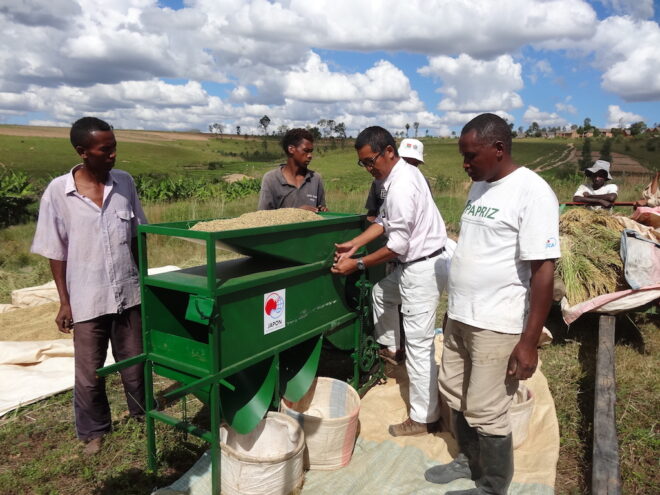
A Japanese expert teaches how to use a winnower as part of the Project for Rice Productivity Improvement and Management of Watershed and Irrigated Area (PAPRIZ Phase 2) in Madagascar.
COURTESY OF JICA
CARD’s goal of doubling rice production by 2018 is likely to be almost achieved. But the gap between rice supply and demand is still large, and Africa remains dependent on imported rice. Facing this situation, the coalition members agreed to commence CARD Phase 2 in 2019 at the 7th CARD General Meeting, which was held in Tokyo in October 2018. They also agreed on the basic framework of CARD Phase 2; expansion of CARD assistance recipients to thirty-two African states, further doubling rice production (to 56 million tons) by 2030 as a goal of the new phase, and adoption of the RICE (Resilience, Industrialization, Competitiveness, Empowerment) approach.
“Japan will continue to play a significantly critical role in promoting rice cultivation in Africa. Africa still has very few rice experts, while Japan has rich human resources with world-leading knowledge and expertise. In addition, Japanese technologies and quality work in agricultural and civil engineering can also be said to be one of the best in the world,” says Satoyama. “Japanese companies’ investments are also important. Only about 20% of African arable land is developed. Africa has extremely high agricultural potential. It will be necessary to boost private investments with all-out national unity, including government initiatives.”
SAWAJI Osamu, The Japan Journal








